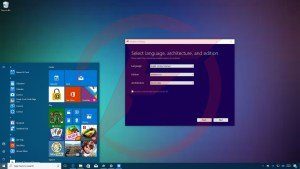How to install, reinstall, upgrade and activate Windows 10

This article covers the most common scenarios you’re likely to encounter when installing, reinstalling, and activating Windows 10.
Is it still possible to upgrade a PC to Windows 10 from Windows 7 or Windows 8.1?
For the first year after the release of Windows 10, Microsoft offered free upgrades using the Get Windows 10 app, which appeared in the taskbar as a notification icon and in Windows Update. With the end of the free upgrade offer, the Get Windows 10 app is no longer available, and you cannot upgrade from an older Windows version using Windows Update.
The good news is that you can still upgrade to Windows 10 on a device that has a license for Windows 7 or Windows 8.1. You’ll need to download the installation files and run the Setup program from within Windows or use the Upgrade Assistant available from Microsoft’s accessibility page. For details, see Here’s how you can still get a free Windows 10 upgrade.
As of late May 2018, readers have confirmed to me that this procedure still works.
PCs that have a license to run Windows XP or Windows Vista are not eligible for a free upgrade to Windows 10.
Where can I get installation files for Windows 10?
If you’ve built a new PC or you’re installing Windows 10 in a virtual machine on a Mac, you can purchase a license from third-party sellers or from Microsoft itself, via the Microsoft Store. Windows 10 Home costs $120, and Windows 10 Pro costs $200. Depending on how you purchase, you’ll receive installation media (DVD or USB key) or a product key and instructions for downloading installation media.
Windows 10 tips: Setup and configuration: Don’t settle for default settings | Performance and troubleshooting | Productivity | Networking and security
If you already have a Windows 10 product key or you are planning to reinstall Windows 10 on a machine that already has a digital license (more on that later), visit the Download Windows 10 page and download the Media Creation Tool. This free download allows you to create a bootable USB flash drive directly.
As an alternative, I recommend that you download an ISO file instead. That file can be mounted directly in File Explorer (see Windows 10 tip: Mount and unmount any ISO file instantly for instructions); an ISO file can also be used to create a bootable USB flash drive, a bootable DVD, or a virtual DVD drive mounted in a virtual machine.
After running the Media Creation Tool, choose Create installation media (USB flash drive, DVD, or ISO file) for another PC. By default, the pre-selected options choose an architecture (32-bit or 64-bit) that matches that of the current PC. Open the drop-down list shown here if you want to choose a different architecture or download an ISO file that includes both architectures.
Use this drop-down list to download a specific Windows 10 architecture.
The ISO file for an x86 (32-bit) edition is approximately 3 GB in size. The x64 (64-bit) edition is delivered as an ISO file approximately 4 GB in size. The combined installer is just over 6 GB in size.
Developers and IT pros with a Visual Studio (MSDN) subscription can download installation media in ISO format from the subscriber portal.
Windows 10 Enterprise editions are available through the Volume Licensing Service Center. A free 90-day trial edition is also available from the Microsoft Evaluation Center.
What’s the most recent Windows 10 version?
Microsoft released Windows 10 version 1803 on April 30, 2018. This release is also known as the Windows 10 April 2018 Update.
This major update succeeds version 1709 (also known as the Fall Creators Update), which was released to the general public on October 17, 2017. The two major updates before that were Version 1703 (the Creators Update, April 5, 2017) and version 1607 (the Anniversary Update, August 2, 2016).
Business and enterprise customers who have opted to defer new releases work on a slightly different schedule, with feature updates (the official name for version upgrades) being released approximately four months after the general release date.
In mid-2017, Microsoft revised its terminology for Windows as a Service, dropping the Current Branch and Current Branch for Business monikers. Version 1709 is the current Semi-Annual Channel release. It was declared ready for widespread adoption by business customers on January 18, 2018.
For a full listing of release dates for major versions, see the official Windows 10 release information page.
Each major release is associated with a build number. The initial July 2015 release was build 10240. The build number of subsequent updates are as follows:
Version 1511 – build 10586
Version 1607 – build 14393
Version 1703 – build 15063
Version 1709 – build 16299
Version 1803 – build 17134
A number after the major build number identifies the most recent update installed.
To check which version of Windows 10 is installed on a device, open Settings > System > About. As an alternative, you can click in the search box and type settings:about. The same information is also available using the winver command, which displays results in a compact About Windows dialog box.
The system shown below, for example, is running the April 2018 Update, version 1803, with the May 2018 updates applied.
This PC is running the Windows 10 April 2018 Update.Will Microsoft automatically update my PC to the latest release of Windows 10?
If you’re currently running Windows 7 or 8.1, you will not be offered an upgrade to Windows 10.
If you are running Windows 10 Home, these feature updates (the new, official terminology for what were once called upgrades) are delivered through Windows Update. Feature updates download and install automatically. You can schedule the installation for a more convenient time or postpone it for a few days, but you cannot delay the update indefinitely.
On systems running Windows 10 Pro, Enterprise, or Education, you can delay the installation of a new feature update by moving to the Semi-Annual Channel. That delays the installation of a feature update such as Version 1803 by a few months.
In addition, you can use advanced options to delay feature updates by an additional period of up to 365 days. For instructions, see Windows 10 April 2018 Update: Act fast to delay this big upgrade.
When a feature update is released, it may take several weeks or months to roll out to the huge worldwide installed base of Windows 10 users, a process Microsoft calls throttling. (For details, see Facing complaints, Microsoft adopts a kinder, gentler Windows 10 upgrade pace.)
Each feature update delivered through Windows Update requires roughly 3 GB of bandwidth and disk space. If your PC is running an earlier version (as might be the case if you restored it using the manufacturer’s recovery media) and you don’t want to wait for Windows Update, you can use the Windows 10 Update Assistant to get the latest version. Visit the Download Windows 10 page and click Update Now to start the process.
That action downloads a very small installer file that runs a compatibility check and then, assuming the device passes all compatibility tests, begins the full upgrade. The Update Assistant is a straightforward wizard that doesn’t require technical knowledge to use.
Do I need a product key to install or reinstall Windows 10?
If you upgrade over a properly activated copy of Windows 7 or Windows 8.1, you can run Setup from within your current Windows installation and you will not be prompted to enter a product key. After the upgrade is complete, your new copy of Windows 10 will be activated with what Microsoft calls a digital license.
If you are using bootable installation media to perform a clean install on a PC that was previously upgraded, you do not need to enter a product key. (When you see the prompt to enter a key, click the I don’t have a product key option.)
Because the PC received a digital license as part of its earlier upgrade, Windows 10 will be automatically activated after the installation is complete.
If you are using bootable installation media to perform a clean install on a PC that has never been upgraded to Windows 10 and activated, you will need to enter a product key. You can enter a product key from Windows 10 or from a matching edition of Windows 7, Windows 8, or Windows 8.1. Residents of the United States who don’t own a qualifying Windows license can skip entering a product key and purchase a license online from the Windows Store after setup is complete.
How do digital licenses work?
When you upgrade over an existing, activated copy of Windows, the Setup program checks the current activation status. If it determines the installation is properly activated, it contacts a Microsoft activation server and generates a license certificate that is linked to that hardware. (A Microsoft account is not required for this step; the license is generated for the device, not for its owner.)
This automatic activation process is identical whether you use an ISO file to start the upgrade or do so from the downloaded upgrade files.
After that first activation is complete, you can perform a clean install on that same hardware using Windows 10 installation media. As long as the hardware fingerprint matches the previous installation ID, the installation is activated automatically. (Microsoft does not provide details of what goes into the hardware ID, except to confirm that it does not contain any personally identifiable information and is not used for tracking purposes.)
For details, see Microsoft quietly rewrites its activation rules for Windows 10.
To check the activation status of a Windows 10 PC, open Settings > Update & Security > Activation.
How long does a Windows 10 upgrade take?
That’s primarily dependent on the performance of your system. Windows Setup uses hardlinks to migrate data files, so the amount of data files shouldn’t have a significant effect on install times. Beginning with version 1803, Microsoft has made some changes that speed the process up even more for the twice-yearly feature updates (see Windows 10 feature updates painfully slow? Relief is in sight).
In my experience, the update can take as little as 30 minutes and as much as two hours. Anything more than that indicates a problem.
Except for a few questions at the beginning, the upgrade process runs completely unattended.
What’s the difference between Windows 10 and Windows 10 N?
The N editions of Windows lack media playback capabilities. Microsoft is required to offer these editions as part of a settlement in a European antitrust trial.
You don’t want it. Nobody does.
Can Windows 10 Home be upgraded to Windows 10 Pro?
Yes. In fact, you can apply that upgrade using a spare key from an earlier edition of Windows, including Windows 7 Pro or Ultimate, Windows 8 Pro, or Windows 8.1 Pro. Follow the instructions in this article carefully: How to upgrade from Windows 10 Home to Pro for free.
This procedure is especially useful when restoring Windows 10 on a system that originally shipped with Home edition and was manually upgraded to Pro. In this scenario, you might need to use a generic product key first to upgrade to Pro. After the upgrade is complete, you can activate using the stored digital license or a product key.
My upgrade is complete. Can I delete the setup files?
I recommend that you leave them for now, unless disk space is so tight that you absolutely must remove them.
The Windows.old folder contains files needed to roll back to your previous version if necessary. It will delete itself automatically in 10 days. You can do so manually by running Disk Cleanup Manager in administrator mode and choosing the option to remove your old Windows version. You can also perform the same action by going to to Settings > System > Storage; click the system drive and then select Temporary Files, where Previous Windows Installation(s) is an option.
But don’t do this just because you like a tidy system.
To open Disk Cleanup Manager, click in the search box (next to the Start button) and type Cleanmgr. Right-click the Disk Cleanup entry at the top of the list and choose Run As Administrator.
Use the Disk Cleanup Manager to remove unneeded files after an update.
The setup files themselves are in a hidden folder called C:$Windows.~BT. Because of the way Windows assigns permissions to these folders, you can’t delete them from File Explorer but instead must use one of the previously mentioned system tools.
Having installation files available comes in handy if you need to reset your PC or if you are in the Windows Insider Program and need to roll back a build. I recommend that you leave them intact unless you’re critically low on disk space.
Should I upgrade or do a clean install?
That’s up to you. Windows 10 supports upgrades over Windows 7 Service Pack 1 or later as well as clean installs. To do a clean install, you will need bootable media.
Can I set up Windows 10 as part of a dual- or multi-boot installation?
Yes, but only if you follow some strictly defined procedures.
First, you must boot from installation media and choose the Custom option in Setup.
Second, you must install Windows 10 on a separate disk partition or physical drive; if you choose the same partition that contains an existing Windows version, you will lose access to that Windows installation. (Your existing data files and all current Windows system files will be moved to the Windows.old folder.)
Windows 10 will add itself to the boot menu if you install it in a separate volume on a system that already has a previous version of Windows installed.
Is it possible to uninstall Windows 10?
Yes. For 10 days after the upgrade, you can roll back to your previous Windows version if you experience problems. The option to roll back is in Settings > Update & security > Recovery.
Can I install Windows 10 in a virtual machine?
Yes, as long as the virtualization software is compatible. The desktop Hyper-V feature in Windows 10 Pro/Enterprise is ideal.
How do I send feedback to Microsoft?
You’ll see occasional pop-up prompts that ask questions about your experience with Windows 10. You can click those tiles to send comments, or use the new Feedback Hub app (you’ll find it on the new Start menu.)
More questions? Ask away in the comments below or, better yet, use the contact form below this post to send your questions via email. I’ll update this post with additional answers.




